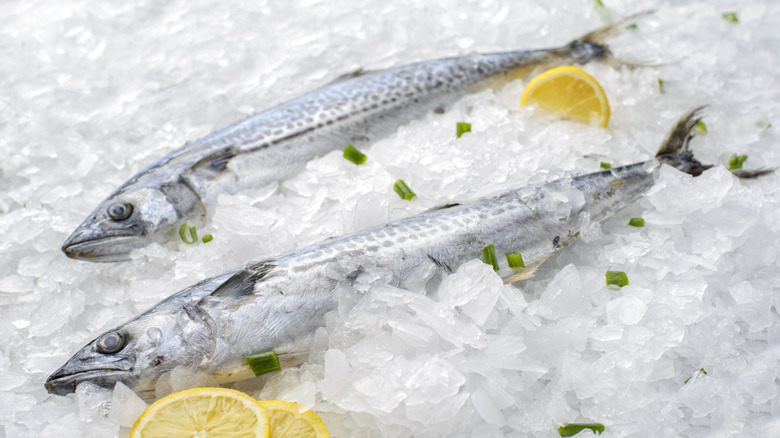Slow Vs Flash-Freezing: Which Is The Best Method For Fish?
Fresh is always better. It's one of the longest standing assumptions around food, and in the overwhelming majority of cases, it's true. Buying foods fresh from farmers, butchers, bakers, or fishers typically yields the greatest quality return. Often, doing so is also the best bang for your buck and the most environmentally sustainable choice logistically. Yet, not everyone has the same opportunities for buying fresh; consider seafood as an example.
If you live in a landlocked state, it may be near impossible to get fresh seafood, with the exception of those critters harvested from rivers, lakes, or bayous. The food industry has created solutions, however — your freezer aisle is full of them. Considering that around 23% of seafood on the market is tossed away (per Ecotrust), freezing fish is an important way to reducing waste as well as provide the opportunity for non-locals to eat coastal catches.
The myth that frozen fish is inherently inferior persists, when in fact, it actually all comes down to how your fish is frozen. Commercially, fresh caught fish are chilled via two primary methods: slow freezing or flash-freezing. It's the latter, flash-freezing, which is the best method for fish. It comes down to science and what's in a name.
Slow freezing squeezes water, flash freezing seizes it
Slow freezing is a process that occurs between around negative 10 and negative 25 degrees Fahrenheit. At this temperature, water still wants to spread, albeit not as quickly. As fish freezes, water within it expands, which can rupture the cell walls and cause meat to become soggy and unshapely when thawed again.
Alternatively, flash freezing occurs anywhere lower than negative 25 degrees Fahrenheit, more typically between negative 40 or even negative 80 degrees Fahrenheit. At this temperature, water isn't given the chance to expand and is instead rapidly solidified in place, retaining the characteristics of fresh fish. To ensure quality of fish that don't immediately make it back to the pier (say, seafood caught on a multi-day trip), the fish is held right around 34 degrees Fahrenheit until it undergoes the flash-freezing process. After it's frozen, it's bathed in water that becomes a coating sheet of ice called a glaze.
Flash freezing as a commercial process has been occurring since the 1930s, when industrial machines were designed for it. Clarence Birdseye is credited with inventing the flash freezer but came to the idea by watching how the natives of Labrador, Canada — the Innu, Inuit, Mi'kmaq, and Southern Inuit tribes — would place fresh-caught fish in direct contact with sea ice to freeze it quickly. These days, high velocity cold air or liquid nitrogen is used to flash freeze seafood.
How you thaw your fish matters too
How your fish was frozen has a significant influence over quality, as compared to whether or not that fish is from the ice box or the pier. That considered, how you thaw your fish plays a role in the final quality too.
Some fish are fine to cook from frozen, like tilapia, but most fish need to thaw under refrigeration for 12 to 24 hours. 40 degrees Fahrenheit is a fine temp to work with, but 34 or 36 degrees Fahrenheit will do you even better.
If you've forgotten to thaw your fish ahead of time and the guests are on their way, a cold water bath is the best way to speed up the process of defrosting fish such as salmon. It will still take some time, but sit it out and don't turn up the temp. Similarly, you should avoid thawing fish in the vacuum sealed bag that it arrives in.
Botulism thrives in a lack of oxygen. If you've defrosted the fish at room temperature, even accidentally, you are putting yourself at a higher risk of bacteria. Instead, prick the bag with a sharp knife or use entirely new containers to thaw your fish in an environment thats inhospitable to botulism. Whether you're baking, roasting, grilling, or poaching, prepare your fish to an internal temperature of 145 degrees Fahrenheit. Rare may be okay for tuna, but most other fish should hit that mark.


